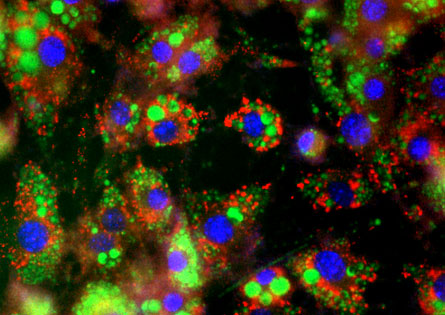Making good, brown fat
Researchers find a way to make energy-burning fat out of other types of cells
 |
|
The energy-burning brown fat cells shown here were made by the skin cells of mice. Green dots are oil droplets, red dots are mitochondria and each blue sphere is the nucleus of a cell.
|
| Shingo Kajimura |
Not all fats are created equal: There’s white fat, which stores energy. There’s also another kind of human body fat that actually burns energy and heats up — a process known as thermogenesis. Babies have this kind of fat, and earlier this year, scientists found that adults have it too. Called brown fat, this substance is stored mainly in the upper body.
According to a new study, it may be possible to make brown fat out of other kinds of cells in the body, such as skin cells. A team of researchers, led by Bruce Spiegelman of the Dana Farber Cancer Institute and Harvard Medical School in Boston, Mass., made brown fat tissue from the skin cells of mice and mouse myoblasts. (A myoblast is a cell that will develop into muscle.)
Because brown fat can burn excess energy, researchers hope it may be used to treat obesity and diabetes. Obesity, which is the condition of being overweight, can lead to other major health problems. Diabetes is a general name given to several different types of illnesses, all of which relate to the body’s ability to manage energy.
In order to make the brown fat cells, Spiegelman and his team started with mouse myoblasts and focused on two proteins. Proteins are the cell’s building blocks and help the cell do its job. The researchers knew that a protein called PRDM16 played some part in converting a myoblast into a brown fat cell, but they had a problem. When they tricked the cell into making more of the protein in a petri dish, nothing changed, and the myoblast cells only formed more myoblasts.
So the scientists looked at another protein, called C/EBP-beta. Just like the first protein, this protein did nothing on its own. But when the scientists added both proteins to the myoblast, the cell created both myoblasts and brown fat cells. They had discovered that the two proteins have to work together.
Even though they were grown in a lab, from other cells, they burn energy similar to normal brown fat cells. “They certainly look like they are brown adipose tissue,” meaning brown fat tissue, Spiegelman says.
There was a difference, however. Normal brown fat cells are able to regulate their energy-burning activity so the human body doesn’t get too hot. The new lab-grown cells, however, are always running on high, which means they’re burning as much energy as possible — which could cause a fever in a person.
The new technique could be used in a number of different ways to help people, says Spiegelman. For example, scientists could remove cells from an obese person, change the cells so they produce brown fat, and return them to the body. Once these altered cells are back in the body, they can produce more brown fat, which would burn energy. Another method may involve injecting an obese person with a compound that could boost his or her production of brown fat cells.
Right now, it’s too early to say whether or not these new brown fat cells will be able to help a person with a weight problem—but the early results are promising.
POWER WORDS (adapted from the Yahoo! Kids Dictionary)
adipose tissue: fat
embryo: An organism in its early stages of development, before birth or hatching
mitochondria: a small organelle, or part of a cell, that converts energy from food into energy that the cell can use
myoblast: An undifferentiated cell in an embryo that is a precursor of a muscle cell.
nucleus: A large structure enclosed in a membrane within a living cell. The nucleus contains the cell’s hereditary material and controls its metabolism, growth, and reproduction.
proteins: Molecules that contain carbon, hydrogen, oxygen, nitrogen, and usually sulfur and are composed of one or more chains of amino acids. Proteins are fundamental components of all living cells and include many substances that are necessary for the proper functioning of an organism
thermogenesis (in biology) The body’s production of heat, usually fueled by food
Going Deeper:







